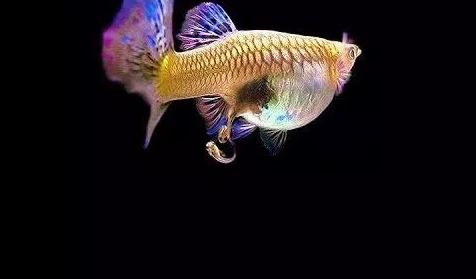How Guppy Fish Give Birth – The guppy spends his days wriggling with happiness. Like a candy with acid colors, this fish as small as dynamic is the joy of many aquarists. Little more? Easy to maintain (it reproduces very easily), it is suitable for beginners. From its scientific name Poecilia reticulata, this peaceful and endearing fish is native to northern South America and the Caribbean.
If the Guppy fish is often called “million fish”, it’s not a coincidence. Great seducer, it is a fish of choice for the reproduction in a ferry. It reaches sexual maturity from the age of two months and females can have up to eleven litters annual, each comprising 20 to 60 fingerlings on average. The incubation is done in the womb and the young are born trained and ready to discover their new biotope.

Males live in a harem and surround themselves with several females to satisfy their spectacular appetite. It is therefore important to provide 3 to 4 females for a male.
Be careful, fry is often devoured by their own congeners.
A nest box to isolate them or a large clump of aquatic moss in the aquarium will provide an excellent shelter the time they grow up
The males are easily distinguished: a gonopod replaces their anal fin and is easily visible. Level morphology and colors, they are smaller and more intense than females.
Small (3 to 6 cm), the guppies are also not very constraining by their taste requirements. Great gourmands, they appreciate granules, glitter, dried daphnia, frozen artemia or mosquito larvae.
Omnivorous, it is essential to add some plants to their diet. Vegetables and herbs will be perfect (zucchini, spinach, basil, cucumber, etc.), even if they readily go in the direct vegetation of their tank.
With their gargantuan appetite, guppies have even been introduced in some countries to fight naturally against mosquito larvae (especially those carrying malaria).
The fact is that here you can see how they are born and how tiny they are. These little fish (Baby Guppy Fish) will be in danger even from the mother herself because they will tend to eat them and should be separated from the other fish to keep them alive. However, some people prefer to leave them in the aquarium and only the strongest survive.
The birth of the fish, specifically the guppies, does not occur on the same day, they can last several days. Keep in mind one thing: you can have 5 and 100 babies at the same time and, of course, that exhausts anyone.
What is essential is that you have one male for every 2-3 females because the males are very “fiery” and would stress the female if she were alone.
With regard to the offspring I think you should not give them anything in particular, they eat the same food as the parents, that is, what you eat daily, so you should not have any problem although I do know that there are specific products for small fish (but I think that’s when they are separated from the big ones).
Births usually occur at night so you may not be able to see them (although others give birth at any time of the day, it depends on how quiet they are.

Comments
One response to “How Guppy Fish Give Birth”